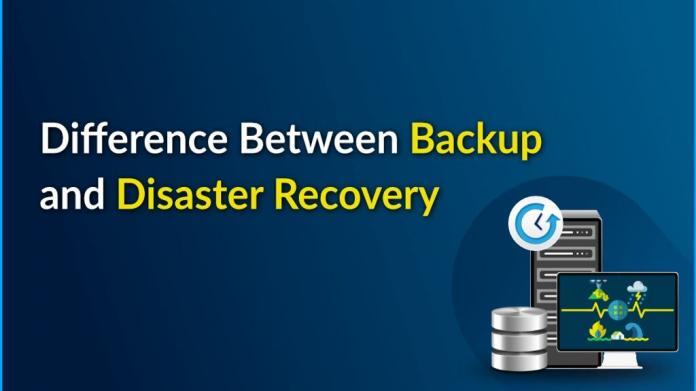Data losses are prevalent today, and cyber attacks have increased in recent years. Organizations’ data has to be protected and available always. Data Backup should be an essential part of any organization’s IT strategy. It is also important for organizations to have a disaster recovery plan.
Disaster Recovery is not the same as Data Backup. In this article, we will discuss the following: What is Data Backup, What is Disaster Recovery and What are the differences between Backup and Disaster Recovery.
What is Data Backup?
Backup refers to keeping a separate copy of data, from which data can be recovered when the original data is lost or in an unexpected situation like infrastructure or service failure happens.
Backing up data varies from one organization to another based on their backup strategy plan. A backup plan is in many forms like storing multiple copies of data in a single data center, storing data at multiple data centers, storing data at a data center in a remote location, and storing data in different media forms like tapes, disks, and cloud storage.
It’s best for any organization to follow the 3-2-1 backup rule. It means keeping 3 copies of data, in which 2 copies of data have to be stored in different media and 1 copy of data stored at a remote location.
Simply backing up data is not just enough to run an organization without any disruptions. To maintain the efficient working of an organization even at unforeseen events like disasters and to prevent any losses, organizations need a disaster recovery plan as well.
What is Disaster Recovery?
Disaster recovery is the process of storing data at a separate location and recovering data at the right time to maintain the normal functioning of an organization by keeping critical access to IT infrastructure and systems to prevent data loss. Disaster recovery takes measures to ensure normal operation at an organization after an unavoidable incident like a disaster occurs. Disaster recovery is a complicated process when compared to data backup.
Implementing disaster recovery depends on backup and disaster recovery solutions. Some Backup & DR software create separate copies of critical VMs in another location and keep them in a ready state while some allow you to host a copy of backup data in a remote location and restore when required. This process mainly involves transferring data to separate locations to run the operations from another site during any downtime quickly and again and then transferring the data to the primary location once all the issues are resolved.
The main purpose of disaster recovery is to avoid the downtime of your business and minimize the effect of an unexpected event on your infrastructure.
How is disaster recovery different from backup?
Backup alone is enough to protect a certain part of the infrastructure and business data. This is well applicable to files and folders that are not part of regular business operations. For example, an organization generally doesn’t need a disaster recovery plan for employee’s desktops. If a laptop got broken or stolen, you can replace it with a new laptop and recover data from a backup as your business operation will not be affected.
Whereas Disaster recovery is required to protect the infrastructure and services for businesses to operate on a daily basis. For example, In an organization, all the employee’s laptop act as a client to the server as it depends on the server to operate. Any disruption to the database or server will affect the entire operation of the business as the employees will not be able to operate on their workstations. This event is more dangerous when compared to individual workstation breakage.
For this situation, you need a Disaster Recovery solution to protect the data and server. Disaster recovery software ensures to restore data and service quickly at the right time, to make employees continue their work before stopping their business operations.
In backup and disaster recovery plans, Recovery time objective (RTO) and recovery point objective (RPO) are the two important terms that have to be mentioned.
- RTO (Recovery Time Objective) is the amount of time your organization needs to recover data following an unforeseen event to avoid any serious consequences
- RPO (Recovery Point Objective) is the amount of data your organization can lose after an unforeseen event.
An effective Disaster recovery solution should be stable to accommodate both RPO and RTO. RTO and RPO value can be more for Backup as the single file cannot disrupt the entire business operations. Whereas RTO and RPO value for disaster recovery must be less as disruption to the main site or critical system can halt main business operations.
Resources required for Data Backup and Disaster Recovery are storage and other facilities. Data can be backed up on different storage mediums like disk storage, tape, cloud storage, NAS, etc. Backup solutions reduce the size of the backup by compression thereby reducing space requirements. Data backup cost is mainly of data storage medium and its maintenance cost.
Disaster Recovery plan requires a separate location to set up a disaster recovery environment and hardware that includes data centers and storage systems to be used along with the main site. It also involves utilities and labour costs to maintain the site. A disaster recovery site is a full IT Infrastructure system that is ready for replacement whenever needed. It includes all the hardware, software, and other networking facilities to transfer operations as soon as disruption occurs. This is known as a hot site. Another option that organizations can opt for is to look for disaster recovery as a service to maintain a cold site for a minimal budget.
An organization looking to protect the entire data must employ both data backup and disaster recovery strategy, so that an organization can easily deliver services or products to users at anytime irrespective of any situation.
Choosing the Right Backup and Disaster Recovery Software
When choosing a backup and disaster recovery software for your business, make sure the software has all the necessary features and functionalities. Some of the important features that you need to look into while selecting a backup software are:
- Single backup platform for all IT environments – Virtual, Physical, Cloud, and SaaS Applications
- Centralized Backup Management
- Ensure an RPO & RTO of less than 15 minutes
- Implement the 3-2-1 backup rule
- Replicate a copy of your data to an offsite location, thus ensuring DR
- Create Virtual Machine Replicas for business continuity
Backup Software like BDRSuite, offer all these features mentioned above along with other features to ensure business continuity at an affordable price.
Conclusion
Backup and disaster recovery are important parts of business operations. Having a Backup and disaster recovery software as a part of business strategy ensures that business operations resume during a disaster and ensure more flexibility and scalability to disaster recovery plan.








